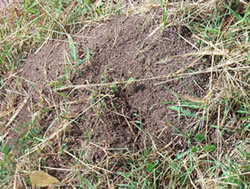Don’t let these ants in your pants
For the first meeting of the year The Garden Club enjoyed a presention by Amanda Ryan a member of the Fire Ant Eradication Team.
Most of us found out stuff that we didn’t know about these creatures and have come away better informed about what to watch out for. We learned how to identify a Fire Ant Nest which interestingly does not have an obvious entrance or exit hole.
 Fire ant nests are mounded with no obvious entry/exit hole.
Fire ant nests are mounded with no obvious entry/exit hole.
Fire ant nests
Fire ants build a dirt nest or mound, which can be up to 40 cm high. The shape and size of the nest varies depending on soil type and colony size. An unusual feature of the mound is that it has no obvious entry or exit hole. The ants enter and leave the mound via underground tunnels which radiate outwards from the nest. These tunnels can be up to 30 m long.
Nests can also develop under logs, rocks or other materials lying on the ground. These materials absorb heat from the sun in the same way that the fire ant mounds absorb heat. Fire ants appear to have an attraction to electricity, and nests have been found in buildings and equipment around electrical systems.
Internally, the nest consists of many interconnecting galleries, which give it a honeycomb appearance.
If a nest is disturbed, the workers may very quickly move the queen and the brood (eggs, larvae and pupae) to a new location.
You can learn lots about Fire Ants and the damage they do from this Video from the Department of Agriculture and Fisheries. Or look on their website.
Have a look at the video
We also were interested to see how badly a fire ant can bite and sting and how dangerous they can be.
So remember what happened with these guys
And don’t let this happen with Fire Ants.



